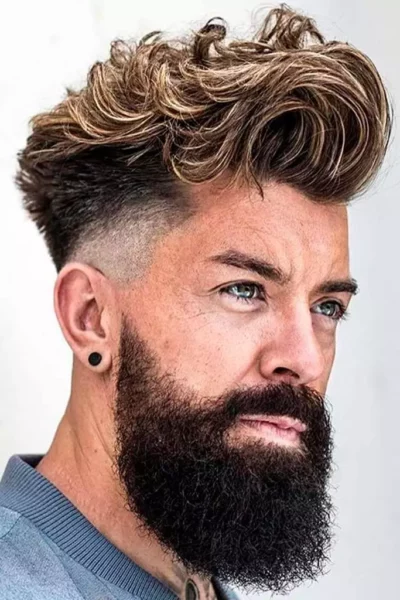Unraveling the Mystique of Beard Growth Patterns
Ah, hair today, gone tomorrow! But for men of us who choose to embrace the follicular phenomenon of facial hair, understanding beard growth patterns can be a game-changer.
From the distinguished gentleman to the rugged outdoorsman, our beards have the power to define our personal style and express our unique identities.
In this captivating exploration, I’ll delve into the wild and WONDERFUL world of beard growth patterns, revealing the hidden secrets that lie beneath our whiskers.
Discover the mysteries, variations, and trends that govern our facial fuzz, and learn how to tailor your own beard to perfection.
So, whether you’re an aspiring beard aficionado or a seasoned pro, let’s embark on a hirsute journey, as I unravel the intricate tapestry of beard growth patterns that make each face a masterpiece of its own.

Understanding Beard Growth Patterns
Beard growth patterns refer to the unique way facial hair grows on each individual.
Factors such as genetics, hormones, and age all play a role in how your beard will grow.
Some men may find their facial hair growing evenly, while others may experience patches or varying growth rates.
As a hairstylist, it’s my job to help clients work with their natural patterns to achieve their desired look.

Genetics and Beard Growth Patterns
When it comes to beard growth patterns, genetics is the primary factor that determines how your facial hair grows.
Your genetic makeup is responsible for the thickness, density, and color of your beard.
Although we can’t change our genes, understanding their influence can help us make informed decisions about styling and grooming.

Hormones and Their Impact
Hormones, particularly testosterone and dihydrotestosterone (DHT), play a significant role in the development of facial hair.
These hormones regulate the growth, thickness, and density of your beard.
To promote healthy beard growth, it’s essential to maintain a balanced hormonal level through a healthy lifestyle, including proper nutrition and exercise.
Age and Beard Growth
Age is another factor that affects beard growth patterns.
As we age, our hormone levels fluctuate, leading to changes in the rate and pattern of facial hair growth.
Typically, beard growth accelerates during the late teens and early twenties and stabilizes as we reach our thirties and beyond.
Nutrition and Beard Growth
A well-balanced diet is crucial for promoting healthy beard growth.
Nutrients such as vitamins, minerals, and proteins are essential for hair follicle health, and a deficiency in any of these can lead to slow or patchy growth.
Ensure you consume a diet rich in these nutrients to give your beard the best chance to thrive.

The Stages of Beard Growth Pattern
The Early Days
The first stage of beard growth typically begins during puberty, with fine, light hairs called vellus hairs appearing on the face.
This stage may last several years, and the pattern of growth may not yet be fully established.
Transition to Terminal Hair
As time goes on, these vellus hairs become darker and coarser, transitioning into terminal hairs.
This stage is characterized by increased density and thickness of the beard, which may take a few years to fully develop.
Mature Beard Growth
The final stage of beard growth is marked by a well-defined pattern, with terminal hairs covering most of the facial hair area.
At this point, the beard growth pattern is usually quite stable and can be more easily managed and styled.
Embrace Your Unique Pattern
As a celebrity hairstylist, I always encourage my clients to embrace their natural beard growth patterns.
No two beards are exactly alike, and that’s what makes them intriguing and unique.
Work with your individual pattern, and you’ll be well on your way to achieving a facial hair look that’s perfect for you.

Conclusion
Understanding beard growth patterns has been an enlightening experience.
By appreciating the mysteries and variations in facial hair, I’ve learned to tailor my client’s beards to perfection.
Embrace your own unique growth pattern, and you too can UNLOCK the full potential of your whiskers – creating a style that truly reflects your individuality.
FAQs
Q1. What are the reasons for the varying patterns of beard growth?
Beard growth patterns are primarily determined by genetics, which plays a significant role in how fast and thick your beard grows. Hormones, age, and nutrition also influence beard growth patterns. Hair follicles on your face are not evenly distributed, so you may notice sparse or patchy areas in some beard growth patterns. Additionally, stress and other lifestyle factors can affect the quality and growth of your beard.
Q2. Is it possible to alter the growth pattern of your beard?
While you cannot change your genetics, you can alter the growth pattern of your beard to some extent. You can adopt healthy habits and use products that promote hair growth such as beard oil and supplements, but consistency is key. Regularly trim your beard to keep it looking neat and well-groomed, which can help stimulate hair follicles and improve growth patterns over time.
Q3. When does beard growth reach its peak and cease to improve?
Beard growth can peak in your mid to late 30s, after which it will slow down or stop altogether. Some men may experience patchy or uneven beard growth as they age, which is normal. Continue to take care of your beard and nourish the hair follicles with healthy products, but be aware that your beard’s growth potential will eventually reach its limits.
Q4. What is referred to as the awkward phase of beard growth?
The awkward phase of beard growth is the transition period between a short and neatly trimmed beard and a fuller, more mature beard. During this phase, your beard may look patchy, uneven, or out of control. But don’t despair – this is a common part of the beard growth process that many men experience. Keep grooming and nourishing your beard, and with patience and perseverance, you’ll get through this phase and achieve a fuller, more refined beard pattern.
Q5. Can trimming your beard daily accelerate its growth process?
Trimming your beard daily does not necessarily accelerate its growth process. In fact, over-trimming or shaving too often can damage hair follicles and slow down the beard growth process. However, regular grooming and trimming can help keep your beard looking polished and promote better growth patterns. Be gentle when trimming your beard, use sharp scissors or clippers, and follow a consistent trimming schedule to maintain a healthy and well-groomed beard.
references
If you’re eager to grow a glorious beard, it’s hard to accept that it simply takes time. source
A beard is the hair that grows on the jaw, chin, upper lip, lower lip, cheeks, and neck of humans and some non-human animals. source
Khamis Maiouf is a professional barber who graduated from Hinckley College in England with a degree in hairdressing. He has also won several barbering contests and successfully operated a barbershop for the last two decades. As a skilled hair stylist for 20 years, his goal is to teach others how to achieve a beautiful appearance through their hairstyles.
